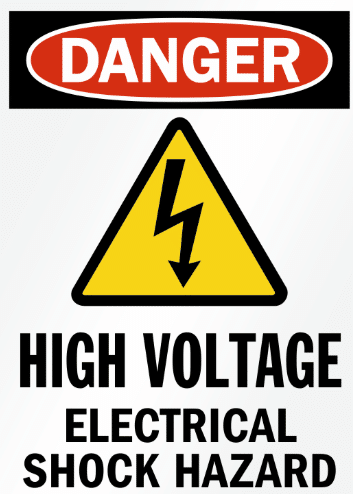Ideas for Improving Hipot Safety
Cirris hipot testers are designed to be as safe as practically possible. Injuries from hipot test equipment are very rare. Still, not every hipot test situation is safe. There are always things you can do to increase the safety and reduce the risk a hipot test might present. This page outlines some ideas you can use to design a safe hipot test environment.
Learn about OSHA
The “Occupational Safety and Health Act of 1970” makes it clear: workplace safety is the responsibility of an employer. Ultimately, employers are held accountable for the safety of their employees. Learn more at: http://www.oshatrain.org/
General Safety
High voltage is just one of the hazards you might find in your work environment. To reduce the risk from most hazards consider:
Training is important. Employers should make sure everyone knows how to safely do their job. Supervisors should make sure operators are trained to safely use equipment. Operators should only use equipment when they have the proper training. Learn more at: http://www.oshatrain.org/
Processes are Important. Design your production processes to be safe. Change the design as needed to eliminate every hazard possible. Create designs that “fall back” to a safe state when something fails or breaks down.
Risk Assessment. Perform and document a risk assessment (example: per ANSI ISO 12100) by the end-user, system integrator, and/or qualified third party. Include the specific end-use/ test location(s), Set up, Normal Conditions, Abnormal Conditions (Failure Mode and Effects Analysis), Cleaning, Service/Maintenance, Emergency Conditions.
Preparation is Important. Have safety and emergency response equipment placed in the best possible (readily accessible) locations. Make sure people are trained and prepared to respond to emergencies.
How Risk Varies with Current and Voltage:
The National Fire Protection Association’s “NFPA 70E Standard for Electrical Safety in the Workplace 2018 Edition” states: “Employer and employees shall be aware of the following hazards:”
For AC Voltages
At 5mA, current is perceptible,
At 10mA person may not be able to let go,
At about 40mA, the shock, if lasting 1 second or longer, may be fatal.
For DC Voltages
At 2mA, current is perceptible,
At 10mA person may not be able to let go.
Voltage in General
Voltages less than 30 Vrms or 42 Vdc are considered safe (except when skin is broken).
Hi-pot Test Equipment

- The electrical values and limits (below) must not be the sole basis of safe use of hi-pot equipment.
- Output settings and devices under test can be changed during the life of hi-pot equipment.
- The user/system integrator / and/or qualified third party must perform and document a risk assessment, per ANSI ISO 12100 or other recognized risk assessment methodology.
- Training/procedures/awareness means alone are not as effective as eliminating access to the hazard (such as a suitable test enclosure) and/or implementing suitable engineering controls.
- Implement suitable safeguarding devices/circuits (per ISO 13849-1, Performance Level d (PLd)) to protect personnel.
- Install test fixtures/test enclosures (non-conductive, such as polycarbonate) to prevent personnel access to high voltage during testing.
- Provide appropriately rated protective gloves (see the ASTM Guide to High Voltage rated gloves) to personnel who operate the equipment.
- The user/system integrator shall identify (awareness means / physical barriers) the test boundary.
- Awareness means can include but is not limited to, painted floor markings, audible warning signal, signs, lights, physical barriers (permanent), safety sensing devices (interlocks, light curtains, laser area scanners …) active during testing.
- The user must ensure personnel are outside the test area, minimum 3.0m (10 feet), when high voltage is energized unless a suitable high voltage test enclosure is used.
- Personnel shall be trained in the related hazard(s), safety protocols (including high voltage discharge), proper use of safeguarding, Personal Protective Equipment (PPE), and emergency procedures.
Cirris Tester Safety
Tester |
Safety Performance |
|---|---|
| 1000H, 2000H, 1000H+, Touch 1, 1100H+, CH+, Easy-Touch® Pro | High voltage not considered hazardous live per IEC 61010-1:2010 due to 45 µC charge limit and not considered as presenting a danger per EN 50191:2010 due to 35 mJ energy limit. |
| CH2, (w/o xHVSupply) | High voltage not considered hazardous live per IEC 61010-1:2010 due to 45 µC charge limit and not considered as presenting a danger per EN 50191:2010 due to 35 mJ energy limit. |
| CH2, (with xHVSupply) | Requires safety interlock |
More Information
Georgia State University’s Electric Shock Page shows the physiological effects of a shock.
Bussman’s Safety Basics Book is geared toward power electrical hazards but it is an excellent source of electrical safety information.
High Voltage Safety Issues
For high voltage testing here are some specific ideas to consider:
Know your test equipment. By design and function, the output of hi-pot test equipment (nominal 1 – 6 kV) is a risk of electric shock.

Based on a documented risk assessment (per ANSI ISO 12100, or other recognized risk assessment methodology), develop processes that increase operator safety while using the test equipment. You may want to simplify your training by standardizing on using the same safety processes for all your test stations.
Keep away from high voltage. Keeping people away from high voltage is the best way to keep them safe. To keep people away from high voltage consider:
Test in a dedicated area. Clearly designate an area for high voltage testing. Use safety tape, signs, and physical barriers to draw attention to the area and warn non-test personnel to keep out.
Limit access to the test area. Use “crowd control” stanchions with ropes, ribbons, or chains to block access to large assemblies being tested. Place the barriers so you have a 3.0 m (five-foot) foot space around the high voltage area, unless there is a suitable high voltage test enclosure (non-conductive material, such as polycarbonate) with safety interlock(s) / circuit per ISO 13849-1, Performance Level d (PLd) and other safeguards based on the risk assessment.
Use safety covers or a test jig with enclosure, insulated terminals and safety interlock (see paragraph above) to block access to small assemblies being tested.
If you have a mobile test cart for your hipot tester you can design the cart to carry the stanchions, ropes, and signs needed to limit access to a test area.
Alert/inform people nearby. Use signs and lights to indicate when a hipot test is in process. You may be able to automate the high voltage indicators using output signals from your high voltage tester.

Examples of signs for your test area. Click signs for printable version.
Test only when everyone is ready. Many high voltage testers provide for safety switches to let nearby operators control or abort a hipot test. Some of the uses for these switches include:

- Emergency-Stop “E-Stop” Switch. This switch quickly aborts any hipot test and puts the tester into a safe state. If needed, how can residual charge on the device under test be safely discharged? Pressing the switch latches it to it disable the hipot test. To enable the hipot again, rotate or pull the switch. You should locate E-Stop switches in easy-to-reach spots nearby high voltage test areas.
- Key “Enable” Switch. To allow a hipot test insert and turn the key to the “Ready to Hipot” state. To work in a test area, turn the key to the “Disable Hipot” state, pull the key, and carry the key with you. Key switches are a good way to limit testing to only trained personnel.
- Palm Switches. To allow a hipot test an operator must use each hand to hold down a button. The buttons must be permanently positioned a safe distance away from the high voltage. Minimum 3.0 m (3 feet) if there is no suitable high voltage test enclosure. If there is a suitable high voltage enclosure, the location shall be determined based on the risk assessment and NFPA 70E:2018, Table 130.4 (D)(a) for ac; or Table 130.4(D)(b) for dc. Both palm buttons must be actuated within 0.5 seconds to energize the hipot test.
.As long as the buttons are held down the hipot test will be energized. If either switch is released, the hipot test aborts. This type of system works for fast hipot tests but can be impractical for long duration hipot tests. The palm switches are the safety “anti-tie down” type. Both switches are monitored and must change state (i.e. be released) before the next high voltage test can be energized.
- Safety Mats. Mats can detect the presence of a person in the test area. The mat can be used to automatically disable (prevent) or abort the hipot test if someone is near the high voltage. Apply OSHA guidelines for mat placement, based on speed of travel (“hand constant” or “walking constant” according to the test area and access to the device under test / high voltage terminals (insulated or not insulated) and distance from high voltage). Mats are most useful when sensing the area right next to the high voltage. Be careful not do to design a system where someone can be near high voltage but not detected by the mat. The safety mat must be reliably secured to the floor with fasteners that require a tool for removal, so the mat is not repositioned and its safety function defeated.The safety mat must be “Safety Rated” (safety certified by a Nationally Recognized Test Laboratory or Notified Body and be integrated with the hipot protective device safety circuit.
- Light Curtains. A light current can sense the presence of a person in the test area. The light curtain can automatically disable (prevent) or abort the hipot test if someone is near high voltage. Apply OSHA guidelines for light curtain placement, based on speed of travel (“hand constant” or “walking constant” according to the test area and access to the device under test / high voltage terminals (insulated or not insulated) and distance from high voltage). Light curtains are most useful when sensing the area right next to the high voltage. Be careful not to design a system where someone can be near high voltage but not be seen by the light curtain (i.e reach over, under, around or through). If you use light curtains or safety mats you will likely need a controller. The controller reads the state of the mat or light curtain and signals when it’s safe or unsafe to hipot.Plan for breakdowns. With any safety switches, mats, and controllers, make sure that a common failure leaves the system in the safest possible state. This means if a safety switch wire becomes disconnected or short circuited, the tester must not allow hipot testing.Maintenance is Important. When equipment is calibrated or serviced you should verify and document the correct operation of the safety systems.
An Example Hipot Safety System.
Here is an example of hipot safety system. This system relies on an area being clearly marked and labeled as the “High Voltage Test Area.” The test area uses a warning sign, a key switch, and an e-stop switch. An operator must be trained to follow this process:
- *Start of process
- Turn the key switch to the “Disable Hipot” position.
- Pull the key and keep it with you while building the harness.
- Put away the “High Voltage Testing In Process” sign and/or de-energize the high voltage ON status light.
- Do the assembly work.
- When ready to hipot:
- Put up “High Voltage Testing In Process” sign and/or energize the high voltage ON status light.
- Reset E-Stop switch back to the “Allow Hipot” state.
- Put the key in the switch and turn the key to the “Allow Hipot” position.
- Start the hipot test.
- Stay near the E-Stop switch and:
- Watch the area around the device being tested.
- Alert approaching people to avoid the area.
- If someone enters the area press the E-Stop switch
- then make sure the person receives proper training on avoiding high voltage testing.
- Once the hipot test is complete go back to *Start of process
- In some cases, manual high voltage discharge may be required. Follow the established safety protocol and use of appropriate equipment (such as a “discharge stick”) and PPE (i.e. high voltage rated gloves …)
Nothing is Perfect
This example process is far from perfect. It relies on an operator to carefully follow each step of the process every time. “Remember to put the sign up. Remember to take it down. Watch the test area.” There is a lot for an operator to do. Still, the main problem you’ll experience with any safety system isn’t that an operator forgets something, it is that people judge the risk and take short-cuts when they think the risk is small and the reward is worth it.
The risk assessment should try to reduce reliance on training, procedures, and following precautions from awareness means, where safety depends on human actions.
If possible, eliminate access to the hazard or control the hazard using engineering controls, based on applicable safety Standards such as ANSI ISO 12100 and IEC 61010.
People may misjudge the risk in some situations. Make sure everyone knows the risk of each test system. Reward people who work safely. Don’t reward unsafe behavior.
Plan for Trouble
Encourage people to take emergency response training. “ABC’s” training (Airway, Breathing, Circulation) can be very helpful should someone receive a shock. Basic “First Aid” training is useful should someone become injured after being startled/shocked by high voltage.
Consider getting a “Home Defibrillator” along with a good First Aid kit to help with your emergency response.
Hipot testing can present some risk to operators. With training, careful process design, and proper preparation, employers can reduce the risk of harm from high voltage testing.



